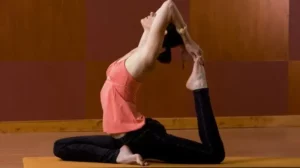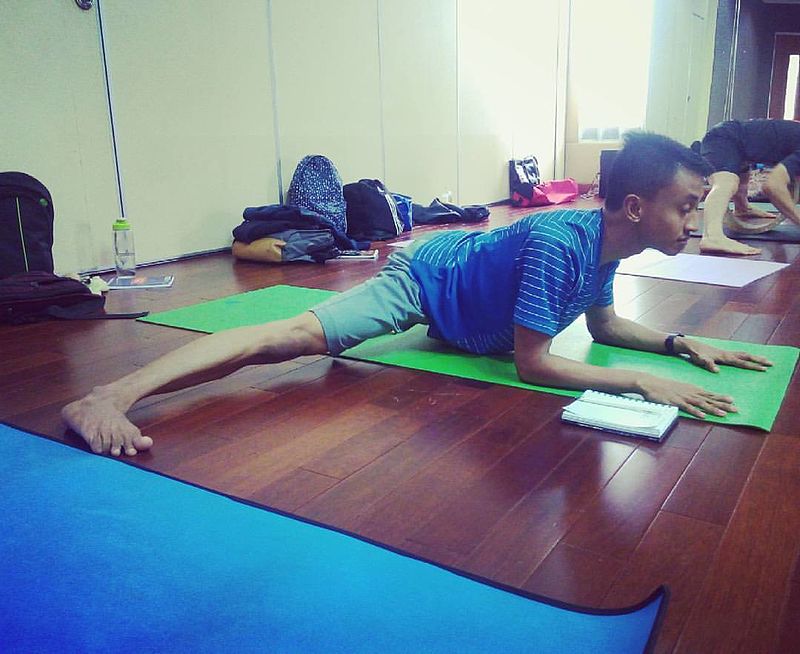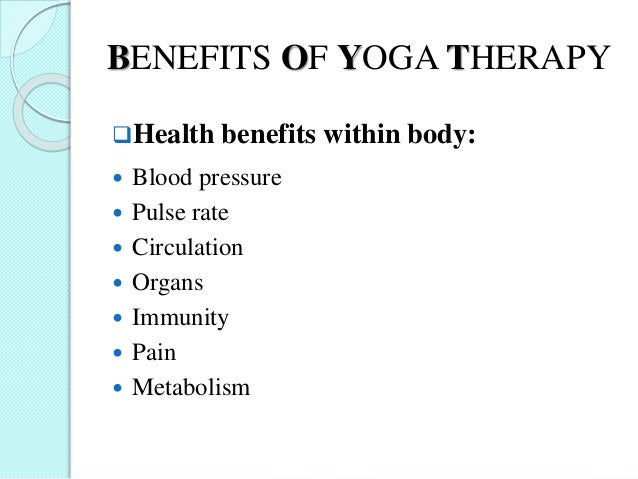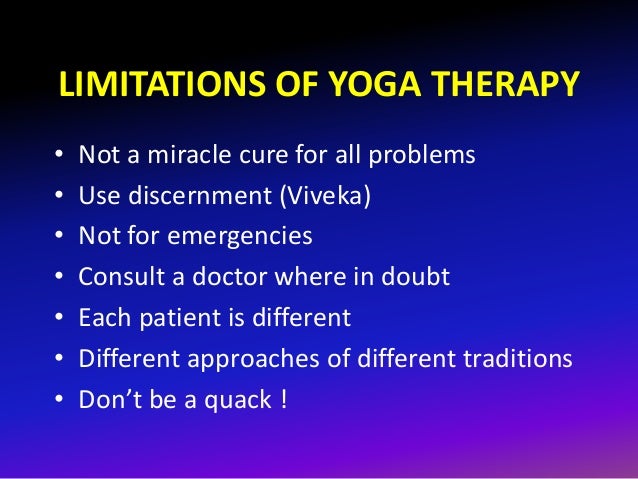Yoga therapy is a practical guide to the benefits of yoga and how it can be used as a treatment for health conditions. It includes information on different types of yoga, when they should be practiced, and what that type will do for your physical and mental well-being. Yoga is an ancient practice that has been around since 500 BC in India with practitioners including both men and women from all walks of life. This blog post also provides useful tips on how to start practicing yoga in your home or at work.
Contents
- 1 What Is Yoga Therapy?
- 2 Uses of Yoga Therapy
- 3 Techniques of Yoga Therapy
- 4 Sanskrit Words Used in Yoga Therapy
- 5 Different Types of Yoga Therapy
- 6 Is Yoga Therapy Effective?
- 7 Future of Yoga Therapy
- 8 How Can One Start Practicing Yoga Therapy?
- 9 Benefits of Yoga Therapy
- 10 Limitations of Yoga Therapy
- 11 Alternative of Yoga Therapy
- 12 Conclusion
- 13 A Word From Therapy Mantra
What Is Yoga Therapy?
 Yoga therapy is the process of using yoga as a form of treatment for an illness or injury. Yoga therapy can be used to help treat physical, mental, and emotional health conditions. This therapy is an alternative to traditional methods of treatment and is often used in conjunction with those practices.
Yoga therapy is the process of using yoga as a form of treatment for an illness or injury. Yoga therapy can be used to help treat physical, mental, and emotional health conditions. This therapy is an alternative to traditional methods of treatment and is often used in conjunction with those practices.
Yoga therapy is based on the belief that the body is a holistic system and that all aspects of it must be considered when treating an illness or injury. The goal of yoga therapy is to restore balance within the body and to improve overall health.
Uses of Yoga Therapy

There can be many uses of yoga therapy as well. This therapy can be used in conditions like:
Anxiety
Yoga therapy can be used to help treat anxiety because it helps the body release stress and tension. Yoga therapy can also help improve breathing, which is an important part of treating anxiety. This therapy can be done on its own or in conjunction with other treatments.
Pain
Yoga therapy can be used to help treat pain because it helps to increase flexibility and range of motion. It also helps to strengthen the muscles around the area that is hurting. Yoga therapy can be done on its own or in conjunction with other treatments.
Depression
Yoga therapy has been shown to be helpful in treating depression. This is likely due to the fact that yoga helps to improve moods and releases stress and tension. Yoga therapy can be done on its own or in conjunction with other treatments.
Pregnancy
During pregnancy, yoga therapy can help prepare the body for childbirth. It can also help reduce some of the common problems that occur during pregnancy, like nausea and back pain. Yoga therapy can be done on its own or in conjunction with other treatments.
Cancer
There is some evidence that yoga therapy may be helpful in treating cancer. This is likely due to the fact that yoga helps to reduce stress and tension, which are known to contribute to cancer growth. Yoga therapy can be done on its own or in conjunction with other treatments.
Eating Disorders
Yoga therapy has been shown to be helpful in treating eating disorders. This is likely due to the fact that it helps to improve body image and self-esteem, which are often damaged by eating disorders. Yoga therapy can be done on its own or in conjunction with other treatments. This therapy can also help those suffering from eating disorders to improve their overall health.
Techniques of Yoga Therapy

There are many techniques of yoga therapy. Some of these are:
Relaxation Techniques
Yoga therapy can help many conditions by helping the patient relax. One way that this is done is through visualization exercises, which allow patients to imagine a relaxing scene or place in their minds. This can help to reduce stress and tension.
Breathing Exercises
Breathing exercises are an important part of yoga therapy. They can help to improve breathing, which is helpful in treating conditions like anxiety and asthma. Breathing exercises can also help to calm the mind and relax the body.
Movement Exercises
Movement exercises can help to improve flexibility and range of motion, which is important in treating certain conditions. These exercises are often focused on the joints, muscles, and bones.
Mindfulness Exercises
In addition to these techniques that directly treat a condition or illness, this therapy includes mindfulness exercises as well. Mindfulness helps patients learn how to focus their attention and be in the present moment. It can help reduce stress and improve moods, which is helpful for many conditions.
Sanskrit Words Used in Yoga Therapy

There are a number of Sanskrit words that are used in yoga therapy to describe different techniques:
Asana
This describes stretching exercises or poses. These may include specific movements as well as meditation while holding these positions. In some cases, this word refers to specific postures meant for particular health conditions like asthma or back pain (e.g., cat pose). Asanas should never cause any discomfort, but instead, they should focus on improving flexibility and mobility over time with consistent practice.
Pranayama – Breathing Exercises.
This includes both breathing patterns as well as the timing of breath. Pranayama can involve breathing exercises that are done to improve specific conditions or it can be practiced for its own benefits like relaxation.
Yoga Nidra – Mindfulness Exercises.
This refers to a particular type of mindfulness exercise, in which the patient focuses on relaxing different parts of their body and mind one by one. Patients should close their eyes during these exercises so they do not get distracted by anything else around them. This technique is also known as yogic sleep because it puts patients into a relaxed state similar to sleep without inducing unconsciousness.
Different Types of Yoga Therapy

There are many types of yoga therapy. The most common types include:
Yoga For Flexibility
This focuses on stretching exercises known as ‘asanas’ and breathing techniques to improve flexibility, enhance mobility, and reduce stress. Yoga is practiced alone or in combination with other therapies like a massage during this type of yoga therapy.
Yoga for Strength Training
This focuses on movement exercises that help patients build strength by focusing primarily on their bones, joints, and muscles instead of improving flexibility (which can be done at the same time). These are also called hatha yoga practices because they focus primarily on physical poses rather than meditation-based mindfulness practices. They may incorporate some aerobic conditioning but only if it does not interfere with overall goals.
Yoga for Relaxation
This focuses on breathing exercises and mindfulness techniques to help patients focus their attention on the present moment. It is designed to reduce stress levels by focusing on positive experiences instead of negative ones, which helps prevent illness. This type of yoga therapy may be used alone or alongside other therapies like meditation or massage depending on overall goals.
Yoga for Mental Health Conditions
These types of yoga therapy include practices that are based on reducing anxiety, depression, and PTSD symptoms as well as treating conditions such as schizophrenia and bipolar disorder (e.g., raja yoga). These types of treatments can also treat addiction because they address underlying causes rather than just symptoms.
Is Yoga Therapy Effective?
 The effectiveness of yoga therapy is still being studied, but the preliminary results are positive. There have been a number of studies that suggest yoga may be helpful for conditions like anxiety, depression, and chronic pain. More research is needed to confirm these findings, but the early evidence looks promising.
The effectiveness of yoga therapy is still being studied, but the preliminary results are positive. There have been a number of studies that suggest yoga may be helpful for conditions like anxiety, depression, and chronic pain. More research is needed to confirm these findings, but the early evidence looks promising.
Some researchers also find that yoga therapy can be helpful to people who have been diagnosed with schizophrenia and other mental health conditions.
Future of Yoga Therapy
As the evidence supporting these types of therapies grows, they will likely become more popular in both Western countries as well as developing nations where access to healthcare is limited because it costs so little. More research also needs to be done on techniques like yogic sleep (Yoga Nidra), which does not appear to interfere with current medications for some psychological conditions but may carry its own risks if patients are taking sedatives or antidepressants without their doctor’s approval.
In addition, there need to be a number of clinical trials that look at specific populations over time before this type of treatment becomes widespread enough for insurance companies to pay for it.
So far, yoga therapy has been found to be helpful in treating a number of mental health conditions, such as anxiety and depression. It may also help people who have been diagnosed with schizophrenia and other mental health conditions. Yoga therapy is still being studied, but the preliminary results are positive. More research is needed to confirm these findings. In addition, there need to be a number of clinical trials that look at specific populations over time before this type of treatment becomes widespread enough for insurance companies to pay for it.
How Can One Start Practicing Yoga Therapy?
If you’re interested in practicing yoga therapy, your best bet is to find a local instructor who can teach you the basics. There are also many books and online resources available to learn the basics, but it is best to receive hands-on instruction.
Yoga trainers are also available in most areas of the country. You can contact them directly or visit a yoga studio that offers yoga therapy and find out if they have any sessions you can attend.
If none of these options work for you, there are online resources where you can listen to audio recordings or read instructions on how to do various exercises including breathing techniques (e.g., Pranayama). The poses themselves cannot be done without an instructor present because each pose requires proper alignment as well as modifications depending on your physical capabilities and specific needs, so this type of self-care should only be practiced with qualified supervision.
Benefits of Yoga Therapy

There are many benefits of yoga therapy, some of which are:
Improves Mental Health
Yoga therapy helps to improve mental health by reducing anxiety, depression, and PTSD symptoms. It also helps to treat conditions such as schizophrenia and bipolar disorder.
Reduces Stress
Yoga therapy can help reduce stress levels in the body. This is because it teaches people how to breathe deeply and relax the mind and body.
Helps with Chronic Pain
Studies have shown that yoga may be helpful for chronic pain. Yoga therapy can help to release tension in the muscles and connective tissues, which can lead to a reduction in pain.
Improves Flexibility and Strength
Yoga therapy can improve flexibility and strength. This is because many of the poses require you to hold them for an extended period of time, which builds muscle endurance and flexibility.
Makes You Smarter
It may sound strange, but yoga therapy can actually make you smarter. This is because it helps to improve focus and concentration, which allows people to learn and remember information better.
Limitations of Yoga Therapy

There can be many limitations of yoga therapy as well:
Can Be Time-Consuming
Many experts believe that this therapy can be time-consuming and difficult to practice on your own. This is because you need to learn the poses and how to modify them depending on your needs.
May Be Dangerous if Not Done Properly
If one does not do yoga properly it can be dangerous. This is because some of the poses can put pressure on the spine and other joints, which can lead to injuries.
Not All Yoga Poses Are Suitable for Everyone
Certain yoga poses should not be done by people who have certain health conditions. For example, pregnant women should avoid doing any inversions (poses where you are upside down).
Alternative of Yoga Therapy

There can be many alternatives to this therapy as well. Some of them are:
Meditation
Yoga is not the only form of meditation out there. There are many other forms, such as Transcendental Meditation and Vipassana (a Buddhist-based practice). Each method has its own benefits that may or may not overlap with this therapy.
Tai Chi Chuan/Qi Gong
These ancient Chinese practices are very effective in improving mental health conditions like anxiety, depression, PTSD symptoms, and schizophrenia. Tai chi chuan focuses on physical movements while qigong consists mostly of breathing exercises. It’s best to learn these techniques from a certified instructor who can show you how to do the specific poses correctly before attempting any type of self-care without supervision if necessary.
Massage
Massage is another form of alternative therapy that can be helpful for chronic pain, stress relief, and improved flexibility. Like this, it should only be practiced by a certified massage therapist to avoid any injuries.
Acupuncture
This traditional Chinese practice involves the use of needles inserted into specific points on the body. Acupuncture can be helpful in treating conditions like chronic pain, anxiety, depression, and infertility. It’s best to find an acupuncturist who has experience with treating your specific condition.
Herbal Medicine
There are many different types of herbal medicine available and each one has its own set of benefits and risks. Some herbs may interact with prescription medications you’re taking, so it’s best to speak with a healthcare professional before starting any type of herbal therapy.
Creative Arts Therapies
There are many different forms of creative arts therapies, such as music therapy, art therapy, and dance/movement therapy. These therapies can be helpful in treating conditions like anxiety, depression, PTSD symptoms, and chronic pain. They can also help people connect with their emotions and improve communication skills.
Conclusion
In conclusion, yoga therapy can be beneficial for many people, but it may not work for everybody. It’s best to speak with a healthcare professional before starting any type of self-care practice if you have certain health conditions or are taking prescription medications.
In addition, there are many alternatives to this therapy out there that you should consider trying instead. This is because some forms of alternative therapies may be more suitable for your needs than others depending on the condition(s) you’re hoping to treat and how severe they are.
A Word From Therapy Mantra
Your mental health — your psychological, emotional, and social well-being — has an impact on every aspect of your life. Positive mental health essentially allows you to effectively deal with life’s everyday challenges.
Also, at Therapy Care, we have a team of therapists who provide affordable online therapy to assist you with issues such as depression, anxiety, stress, relationship, OCD, LGBTQ, and PTSD. You can take our mental health test. You can also book a free therapy or download our free Android or iOS app.
You can visit YogaMantra to know more about online yoga programs and their benefits.


